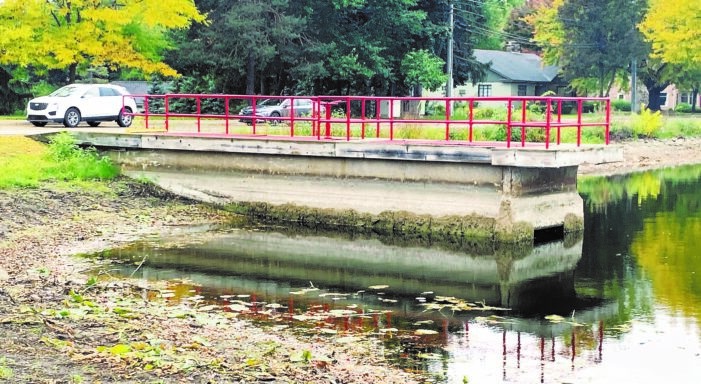By Matt Mackinder
Clarkston News Editor
Recently, many Clarkston residents have inquired about the water levels in the mill pond, which are controlled by the privately-owned dam.
Neither the city or the Mill Pond Association have any authority to adjust the dam, located near the intersection of Main and Washington streets, or otherwise modify water levels within the pond.
Traverse City-based attorney W. Dane Carey, of the Kuhn Rogers law firm, sent out a letter Oct. 11 to area stakeholders (Clarkston Mayor Eric Haven, Clarkston City Manager Jonathan Smith, Independence Township Supervisor Gerald Fisher, Oakland County Commissioner Karen Joliat, Oakland County Water Resources Commissioner Jim Nash and WRC representative Jacy Garrison, and Clarkston Mill Ponds Lake Improvement Board Riparian Representative Frank Schoebel) about the future of the dam. Carey’s office represents the dam’s owner, Lehman Investment Company LLC, Ed Adler and Bob Roth.
“The letter was prompted, honestly, by the reasons stated in the letter, that they would rather remove the dam than continue to maintain it and face legal liability in the event of a failure,” Carey said. “Next, we are hoping to work out an arrangement with one or more of these organizations to transfer control of the dam to them. If no one will take over the dam, then we will take the steps needed to obtain approval to remove the dam entirely. That will be an expensive and effort intensive process that my clients would prefer to avoid if possible.”
The letter from Carey details options for the dam.
“As some of you may know, the dam was constructed in 1900,” said Carey. “Our clients have been the presumptive owners of the dam for the past half century based on Lehman’s acquisition of Lot 115 in the Assessor’s Plat of Clarkston. Based on our review of the title history and surveyed plat, we do not believe this property includes the dam. We believe the dam is partially located within the public road under the jurisdiction of the City of the Village of Clarkston and partially located on Outlot B of the Assessor’s Plat of Clarkston, the ownership of which is presently unclear.
“Nevertheless, despite the uncertainty of ownership, our clients have assumed the responsibility for maintenance and control of the dam over many decades. Notably, our clients derived absolutely no benefit from this role. They chose to do so as upstanding members of the community for the benefit of local residents and owners of property located on the mill pond. On several occasions, our clients agreed to incur substantial costs and expenses in order to repair and maintain the dam. These costs and expenses were not shared by local residents or waterfront owners who enjoyed the benefits of the dam; they were paid entirely by Mr. Adler and Mr. Roth.”
Carey went on to say that “for many years, these efforts were appreciated by the public.”
“Unfortunately, this is no longer true,” Carey said. “Owners of property on the mill pond constantly complain about the water level and have publicly accused our clients of wrongdoing and unlawful activity. As a consequence of this unfortunate development, our clients have attempted to transition control of the dam to the stakeholders most interested in its long-term stability, including each of your organizations and the owners of property fronting on the Mill Pond. Thus far, no one has been willing to accept this responsibility.
“As Mr. Adler and Mr. Roth grow older, they are beginning to plan for succession to the next generation. This has caused them to evaluate the long-term plan for the dam and the continued viability of maintaining and controlling this public asset. After observing the fallout from the Edenville Dam failure over the past two years, Mr. Adler and Mr. Roth are no longer willing to provide a free public service while retaining all potential liability in the event of a dam failure.”
Carey has set a deadline of the first of the year to get a plan in place.
“In the meantime, we intend to begin working with the Michigan Department of Environment, Great Lakes, and Energy Dam Safety Program staff and Department of Natural Resources Fisheries Division staff to initiate the process of planning to remove the dam,” said Carey. “This would restore the Clinton River to its natural state and eliminate the mill pond as it currently exists. Our clients would, of course, take every precaution necessary to avoid any impact this might otherwise have on Washington Street and the public utilities located near the dam.
“If there is not a meaningful prospect of someone else taking responsibility for the dam by Jan. 1, 2023, we will engage an engineering firm and dam removal consultant to map out the plans to remove the dam. This process will involve significant efforts and financial cost to our clients. It is our hope that those with a vested interest in preserving the mill pond in its current state will step up and assume responsibility for the dam before our clients are forced to expend substantial time and money seeking a removal order.”
PHOTO: Clarkston’s mill pond dam was first constructed more than 120 years ago and sits near the Main and Washington intersection. Photo: Matt Mackinder

